Vaisakhi: “Day to Remember Martyrdom Of Guru Tegh Bahadur Ji to Save Sanatana Dharma”
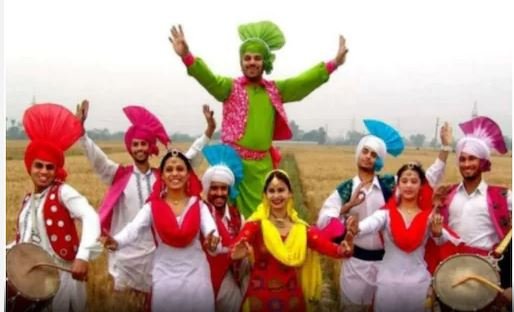

“The greatest comforts and lasting peace are obtained when one eradicates selfishness from within”. Guru Gobind Singh Ji
Vaisakhi (ਵੈਸਾਖੀ or ਵਸਾਖੀ, also known as Baisakhi), is a very important day for Hindus and Sikhs, especially those living in the Indian state of Punjab and Haryana, and one of the most colorful events in the Hindus calendar.
Vaisakhi is celebrated during mid-April every year and traditionally concurs in Punjab with the first harvesting of the crops for the year. Like most Indian Festivals, Vaisakhi also has historically been a very joyous occasion and a time for celebration.
As per the Hindu calendar, Vaisakhi falls on the first day of the Vaisakha month and marks the sun’s entering of Mesha Rashi (also called Mesha Sankranti, i.e., the solar transits into Aries). Vaisakhi is therefore determined by the Hindu Solar calendar.
As per Georgian Calendar, Vaisakhi usually falls on April 13th or 14th, but also on April 15th once every thirty-six years. But it has now been agreed for Vaisakhi to always fall on the 14th of April.
In Punjab, it is also the day when Punjabis celebrate their New Year. But as per Hindu Solar Calendar, Punjabi New Year is celebrated on the 1st day of Chaitra month, which usually falls in mid-March and the year starts from there.
Vaisakhi is also marked by the very significant religious event of the creation of the Khalsa Panth by Guru Gobind Singh Ji in 1699.
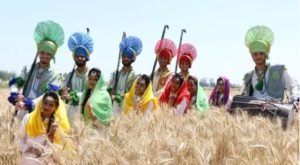
History has witnessed that for the last 1000 years, Hindus have faced the most religious persecution than all the Abrahamic religions combined together.
This atrocious persecution was started during the Mughal Rulers but was increased million times when Aurangzeb seized the throne of the Mughal Empire from his brother Dara Shikoh. Aurangzeb arrested his father and took the Imperial name of Alamgir-I, which means the seizer of the Universe, besting his father who had styled himself, Grabber of the World, in 1657.
Aurangzeb coming to the throne proved a big disaster for the people of Bharat (now called India) and those who dared to challenge his policy of religious persecution faced barbaric persecution as he set in motion the process of the Islamization of India.
Aurangzeb’s primary target was the Hindu Brahmins community as this community is responsible for all the religious ceremonies of Hindu Culture.
He reinstated the unethical religious tax called “jizya or jizyah” on the Hindus. Hindu temples and places of learning were shut, torn down, and often replaced with Masjids, which were also built from the stones of the Hindu Temples.
Aurangzeb believed that once the highly respected Kashmiri Brahmins accepted Islam, the Hindus of all varnas (Kshatriyas, Vaishyas, and Sudras) would then follow suit.

In 1675, the Brahmins of Kashmir were given an ultimatum by Cruel Aurangzeb — “Convert or Die”. Kashmiri Brahmins also known as “Kashmiri Pandits” were scared by the thoughts of death, rape, and torture for themselves and their loved ones. When the time allotted for their answer was almost up, they looked for a dynamic leader to help in their fight against this subversion.
Well respected Kashmiri Brahmin, Pandit Kirpa Ram went to Guru Tegh Bahadur Ji and sought his intervention. Kashmiri Brahmins asked him for guidance on combating the atrocities being committed by the Mughal dictator Aurangzeb.
When the meeting was being held, Gobind Rai, the nine-year-old son of Guru Tegh Bahadur Ji was sitting beside him. As Guru Tegh Bahadur was deep in contemplation, thinking of the problem, his young son asked the reason for his concern. Guru Tegh Bahadur said that the matter was of vital importance as the world is aggrieved by Aurangzeb’s brutal oppression and no brave man had yet come forward who was willing to sacrifice his life to free the earth from the burden of Aurangzeb’s persecution.
At that moment, Gobind Rai replied, “For that purpose who is more worthy than you, my father.” So, after entrusting the Guruship to Gobind Rai, Guru Tegh Bahadur and several of his disciples proceeded to Delhi, the seat of the Mughal Empire. But, before reaching Delhi, the Guru and his loyal attendants were arrested and put in chains by the cruel Mughal Ruler Aurangzeb.
Guru Tegh Bahadur Ji had foreseen the beginning of his ecclesiastic journey in prison.
Scriptures mention that to test his son’s (Gobind Rai later called Guru Gobind Singh Ji) courage and capability to carry on the Guru’s mission, he wrote him saying, “My strength is exhausted, I am in chains and I can make not any efforts. Says Nanak, God alone is now my refuge. He will help me as He did his Saints.”
Replying to his father-child, Guru Gobind Rai wrote: “I have regained my Power, my bonds are broken and all options are open unto me. Nanak, everything is in Thine hands. It is only Thou who can assist Thyself.”
Guru Teg Bahadur offered his life for the freedom of all, not just his own group of disciples, but for those of another religion to be able to freely choose when, where, and how they would hold their worship. His spirit of sacrifice and courage kindled a similar spirit in the heart of young Gobind Rai.
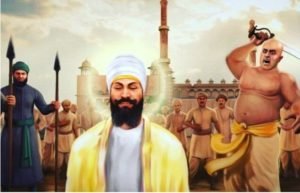
On November 11th 1675, Guru Tegh Bahadur was martyred at Chandni Chowk in Delhi. The cruel executioner had also left the Guru ji severed head and body to lie where they had fallen. No person in the whole country has the courage to claim the body of the fallen Guru Ji or his companions who had died tortured deaths before his eyes. There was alarming fear that who would perform the religious rites of these brave men whom the cruel Aurangzeb had killed. Even the most ardent disciples had withdrawn, unrecognized.
In Chapter 9, Raja Vidhya Yog of Bhagwad Geeta, “Shree Krishna” mentioned to Arjuna that “He is seated within His devotees and will not let them perish. He preserves what they possess and provides them with what they lack. Hence, we should dedicate our mind and body to Him, worship Him, always think of Him, and make Him our supreme goal”.
On the persecution evening, Lord Krishna created stormy weather and taking advantage of the stormy weather one Hindu man managed to take the severed head of Guru Tegh Bahadur Ji to his family back in Anandpur where the appropriate rites were given to the noble Guru.
Another Hindu man, assisted by his sons, secreted the Guru’s body away before it would surely be quartered or hung on display by Aurangzeb’s minions. They used their humble home as the Guru’s secret funeral pyre, as any proper cremation would have brought down the wrath of the frustrated Aurangzeb on their heads.
Cruel dictator Aurangzeb had lost in this challenge to his plans for Guru Tegh Bahadur Ji and had endured all of the tortures and lures that the mighty Aurangzeb could muster. Neither he nor any of his companions had taken the easier road and abandoned their Sanatana religion and principles.
Gobind Rai would now seek to endow each of his disciples with the iron will and fortitude of his father. Although for the time being, the Kashmiri Brahmins also called Kashmiri Pandits were safe, but Guru Gobind Rai now worked to prepare his disciples for the coming storm.
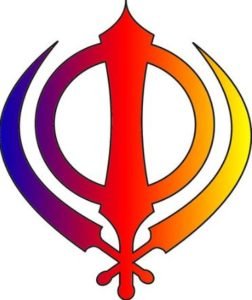
Gobind Rai at a tender age of 9, with infinite courage and strength, takes up the fight to sacrifice against the barbaric rule of “Hindu Blood Thirsty” Aurangzeb.
In 1699 Gobind Rai later called Guru Gobind Singh Ji at age of 33, establishes the Khalsa
During the start of 1699, Guru Gobind Rai had sent special edicts to congregations far and wide telling all the Sangats that, 1699 Baisakhi was going to be a unique affair. The Decree stated, “Not to cut hair and all disciples were asked to come with unshorn hair under their turbans and chunnis, and for the men to come with full beards”.
On Baisakhi Day, March 30, 1699, hundreds of thousands of people gathered around his divine temporal seat at Anandpur Sahib. The Guru addressed the congregants with a most stirring oration on his divine mission of restoring their faith and preserving the Hindu religion. After his inspirational discourse, he flashed his unsheathed sword and said that every great deed was preceded by an equally great sacrifice: Then calling out to the assembled crowd, “My sword is hungry for a head” He demanded one head for oblation. After some trepidation, one person offered himself for the Guru’s “Great Sacrifice“. The Guru took him inside a tent. A little later the Guru came out of the tent, his sword dripping with fresh blood only to ask for another head. One by one four more earnest devotees offered their heads. Every time the Guru took a person inside the tent, he came out with his sword dripping fresh blood.
Thinking their Guru had gone mad and afraid He would ask for more heads some of the congregation started to disperse when suddenly the Guru emerged with all five men dressed piously in white and in a new ceremony that changed the way that one became a Sikh the Guru now initiated the five into a new and unique order of Sikhs.
The ceremony was called “Pahul”, what is now called “Amrit Chakna”. Then the Guru asked the first five Khalsa Sikhs to repeat the same with him.
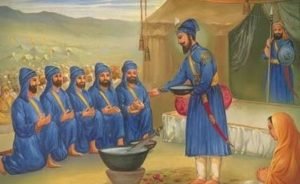
He then proclaimed that the “Panj Pyaare — the Five Beloved Ones” would be the embodiment of the Guru himself:
“Where there are Panj Pyaare, there am I. When the Five meet, they are the holiest of the holy.”
And so, as it was carried out on that historic day, the ceremony of Pahul continues to this day.
The important thing to remember about that day is that the five volunteers and the whole Sangat thought or were “under the impression” that the five disciples were really walking to their deaths–being killed, one by one. The men who volunteered had demonstrated their willingness to give their heads in the same way that Guru Tegh Bahadur Ji had done in Delhi.
The Guru’s bit of showmanship, his seemingly all too real test, was performed to prove the devotion and dedication of his disciples. Those who were ready to give themselves up to their Guru were the bravest and most devoted. These brave men had unknowingly chosen to be part of a new Panth – the Khalsa Panth. Guru Ji joined the Khalsa Panth after his devoted disciples – the initiator becoming the initiated. Today, as then, they lead the Khalsa alongside the Guru:
“Where there are Panj Pyaare, there am I…”
Among the original Panj Pyaare, there was
Guru Gobind Singh Ji gave the surname of Singh to every man and also took the name for himself. From this day Guru Gobind Rai became Guru Gobind Singh. He also pronounced that all women embody royalty, and gave them the surname Kaur.
Guru Ji also gave his new Khalsa a unique, indisputable, and distinct identity. The Guru gave the gift of “Bana”, “The distinctive clothing and headwear”.
He also offered five emblems of purity and courage. These symbols, worn by all “Amrit Dhari” men and women and are popularly known today as the Five Ks:
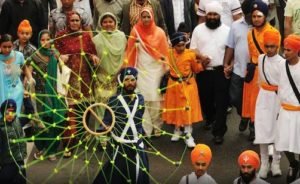
In India, the main celebration takes place at Talwandi Sabo in Punjab. This is where Guru Gobind Singh Ji stayed for nine months, and where he completed the recompilation of the Sikh holy book “The Granth Sahib”.
Large public processions known as Nagar Kirtans take place throughout the states of Punjab, Haryana, Himachal Pradesh, New Delhi, and Eastern Uttar Pradesh. However major cities in India also witnessed Nagar Kirtans.
However, both Hindus and Sikhs communities mark the events that took place on Vaisakhi by making pilgrimages to holy sites.
Around the world many cities that have significant Punjabi populations like London, Leicester in the United Kingdom and New York City, Jersey City (New Jersey), Yuba City (California) in the United States, Sydney and Melbourne in Australia, Toronto, and Vancouver in Canada also hold public celebrations and Nagar Kirtans.
Various Vaisakhi celebrations programs including free community kitchens are also held in various Gurdwaras and Temples across the world.
Although the traditional processions will have to be scaled back for the last 2 years because of the ongoing COVID pandemic which China exports to the world, the Punjabi community doesn’t take the pandemic as a hurdle to rejoice in their favorite festival of “Vaisakhi”.
In the high spirit, Vaisakhi celebrates the integration of the spiritual and temporal worlds, and it provides practical avenues for bringing these to bear through shared values and practices.
Vaisakhi is fundamentally about community, celebration, and progress, and these values are at the forefront of the collective consciousness as Sikhs gather together to mark the occasion
I wish all my readers “A Very Happy, Prosperous and Blessed Vaisakhi”.
I Pray that “May Wahe Guruji accepts your good deeds and fill the coming years with love, compassion, and contentment“.
DISCLAIMER: The author is solely responsible for the views expressed in this article. The author carries the responsibility for citing and/or licensing of images utilized within the text.
